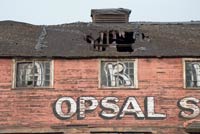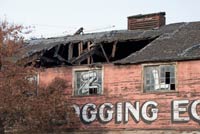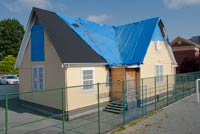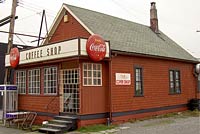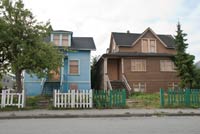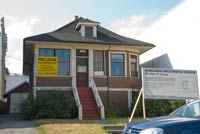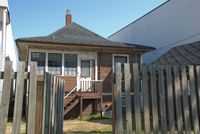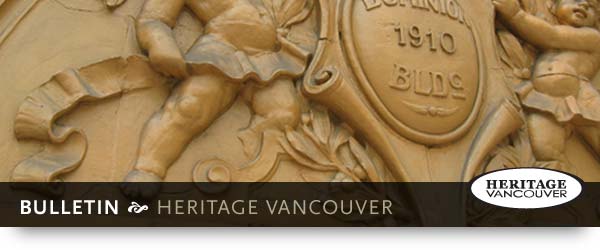 |
|
Endangered Sites Update Problems viewing this e-mail? Read this bulletin from our website Heritage Vancouver Society provides information about opportunities to appreciate, preserve, and restore our heritage structures and neighbourhoods through events, tours, films, forums, and reports. Working with developers, architects, businesses, associations, community groups, and arts and cultural organizations, we are helping to preserve significant heritage structures and neighbourhoods in our diverse city for the enjoyment of future generations. Here are some of the sites and issues that we have been monitoring, and updates to their current status. In addition, our Top 10 Endangered Sites lists from 2001 to 2009 are continuously updated on our website (heritagevancouver.org/topten.htm) Do you know of threatenened heritage resource in Vancouver? Let us know at threat@heritagevancouver.org
Opsal Steel (1918): Ongoing deterioration At this time, the redevelopment permit is suspended in city planning limbo. About seven years ago, Bastion Developments presented it’s initial proposal to move the structure one bay westwards, and remove the Art Deco/Moderne corner office block. Site density was to be transferred to the southeast corner at 2nd and Quebec to erect a tower. The plan included retention and display of industrial artifacts and was approved by the City's Heritage Commission, which added the caveat that the tower base be clear glass, allowing viewing of the artifacts from the street. In this same time period the Olympic Village plans were pushed through planning and were further awarded a two-story density bonus. Meanwhile Bastion and city planning could not agree on the site density to make it viable for the developer. About a year and a half ago, Bastion brought in a new proposal with towers at both southwest and southeast corners separated by the pre-existing car wash and the Opsal building. It had an unusual feature, with the requisite parking accessed off the lane with entrance through the restored timber structure. Inexplicably the Urban Design Panel rejected it. Meanwhile the Olympic Village was granted a further two story design variance impacting Bastion’s/Opsal view, which in turn applied for the same allowance and was rejected by Planning. There has been no movement in bringing the project to council for a vote, where it could likely pass. After seven years of city planning wrangling and a whole area’s density rezoning, Opsal Steel still stands, it’s ninety year old structural timbers still sound, but gaping holes in the roof threaten its structural integrity. This is not so much demolition by neglect as planning by exhaustion. Heritage Vancouver’s perspective is that it would behoove council and city planning to act expeditiously for the sake of conservation and support a proposal to move this plan forward before the structure deteriorates beyond the point of no return. Photos and further info: See Flickr user Photocat62's "Opsal Steel 2009" Gallery::
Firehall #15 (1913): Progress continues The original brass firepole is going back to an alcove off the firetruck bays, and there is a conservation plan to salvage the tin ceiling, the wainscoting and other woodwork. Despite opinions that rainscreening of the exterior walls is not necessary, the City is proceeding to remove and replace all of the original siding, so there will be a lot of unnecessary replication of materials, where there should be preseveration. Photos and further info:
First Shaughnessy: Walter C. Nichol House (1913) - Appears to be Saved Although two days had been set aside for the hearings, there was not the turnout of angry neighbours that was expected. Of the 14 speakers, 7 were for and 7 were against. Most tellingly, the two adjacent neighbours on either side of the development were emphatically supportive and one took the opposing group to task for ignoring this "heritage salvation" by running an "amateurish political letter-writing campaign". The form of the development was approved 9 to 1 so now it's back to Council for what should be an automatic approval. The meeting finished with Brent Toderian addressing the meaning of "precedent " to the neighbours. So with any luck this project will survive all the political interference that it has encountered over the last four years, and the very significant Nichol House and its Arts and Crafts garden setting will be fully preserved. Photos and further info:
Carleton Schoolhouse (1896): Arson update Photo at our Flickr photostream: Save Carleton School blog:
Desnsity & Height in Vancouver's Historic Areas The principles underlying the Gastown Heritage Management plan’s objectives have been sustained by experience and been extended within the Historic District. Within the existing management system there are already significant opportunities for densification. To add further development opportunities conflicts directly with the principles and objectives of heritage conservation, and could seriously disrupt many years of investment in the area's historic fabric. It will also result in an even higher level of density transfer requests than those already challenging the capacity for absorption. Serious damage to the Historic District has already been resulted from the insertion of the two intrusive Woodward’s towers that are hugely out of scale with the surrounding fabric, illustrating the destructive effect of the ‘special sites’ proposal. While the concept of towers on special sites is generally inappropriate, the concept of three of them looming over the Dr. Sun Yat Sen Gardens is especially concerning, conflicting as it does with current City policy respecting site lines from the garden, policy established in recognition of the necessity of protecting the essence of the garden experience. At a recent Heritage Vancouver forum three panellists responded to the query whether the Woodward’s towers would be recognized as an urban design disaster. All three responded affirmatively to this perspective. The concepts around the “Transitions” proposals are also suspect, as there are significant heritage resources in these areas. There is also a broader issue of scale and how framing the heritage areas with highrise towers would impact their character. Gastown and Chinatown could be boxed in. There are also implications if the railway lands commencing 10 feet from Gastown’s northern boundary are redeveloped. The recent stadium debate revived concerns first raised during the freeway debate. This involves the prospect of towers over the rail tracks, and cutting off Gastown from the waterfront, just as the prospect of re-installing a connection to the waterfront has been proposed as part of the Carrall Street greenway. Heritage Vancouver will continue to oppose any further erosion of the character of our irreplaceable heritage areas.
Heatley Block (1931; Houses 1889 & 1898): Threat continues Two properties on the north side of East Hastings, both five lots in size (the Heatley block is only three lots) have been up for sale for the past while, one is less than one block away from the Heatley Block, the other, recently purchased, was one and a half blocks. Neither were heritage, even character buildings; and both had ground floors below street level which would have saved the library excavation costs. The HBPS is currently compiling a list of heritage and character buildings in the 500 to 900 blocks of East Hastings and researching their history. This list of these flagged buildings will be forwarded to the city and VPL Board to help avoid a repeat of the current Heatley Block situation. Extensive photos, articles, links and further info:
Molly's Coffee Shop (circa 1904): Demolished It was located in Lower Mount Pleasant, a rapdily changing area bounded by 2nd, Cambie, West Broadway, and Main Street. Originally the area was all residential, but once the zoning changed decades ago, the historic fabric in the area has been eaten away. Hertage houses still exist in this area, but are increasingly being demolished, partially due to the light industrial zoning. Typical of the area’s endangered stock is the 1888 Lindsay Residence, a Victorian at 144 E. 6th Avenue near Main Street, and possibly the oldest extant house outside of downtown. Built just two years after the Great Fire, the old monarch sits adjacent to a former scrap-yard for sale as an development site. Neglected and stuccoed over, clues to her former glory are still visible, including triple-assembly windows, and a shingled main gable with lunette window and original fascia details. Peel off the stucco, and the original wood siding and other hidden details will still be there. Other immediately threatened examples are two boarded up houses ready for demolition at 302 & 304 West 6th (circa 1905) with their original gingerbread trim now removed, and a virtually unaltered circa 1905 house at 126 West 8th (a demolition permit has been issued). Very few of the remaining houses are even noted on the heritage register. We are actively monitoring the status of this area. See Flickr user Photocat62's "Molly's Coffee Shop" Gallery: Photo at our Flickr photostream: Photos, and our Top 10 Endangered Sites entry from 2008:
Thank you for your support! • Bulletins: Sign-up or view all previous bulletins at: www.heritagevancouver.org/bulletins.html • All upcoming events at www.heritagevancouver.org • Not a member of Heritage Vancouver? Join!
|
||||||
